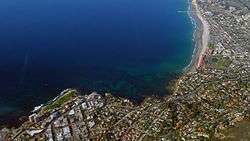La Jolla
| La Jolla | |
|---|---|
| Community of San Diego | |
|
Aerial photo of part of La Jolla | |
| Nickname(s): "Jewel City" | |
 La Jolla Location within California | |
| Coordinates: 32°50′24″N 117°16′37″W / 32.84000°N 117.27694°W | |
| Country | United States of America |
| State | California |
| County | San Diego |
| City | San Diego |
| Population (2004)[1] | |
| • Total | 42,808 |
| ZIP Code | 92037-92039, 92092, 92093 |
| Area code(s) | 858 |
| Website | sandiego.gov/lajolla |
La Jolla (/ləˈhɔɪ.ə/; Spanish: [la ˈxoʎa]) is a hilly seaside community [2] [3][4][5][6] within the city of San Diego, California, United States occupying 7 miles (11 km) of curving coastline along the Pacific Ocean within the northern city limits.
The 2004 estimated population was 42,808.[1] La Jolla is surrounded on three sides by ocean bluffs and beaches[7] and is located 12 miles (19 km) north of Downtown San Diego, and 40 miles (64 km) south of Orange County California,[8][9] The climate is mild, with an average daily temperature of 70.5 °F (21.4 °C)[10][11]
La Jolla is home to a variety of businesses in the areas of lodging, dining, shopping, software, finance, real estate, bio-engineering, medical practice and scientific research.[7][12][13] The University of California, San Diego (UCSD) is located in La Jolla, as are the Salk Institute, Scripps Institution of Oceanography (part of UCSD), Scripps Research Institute, and the headquarters of National University (though its academic campuses are elsewhere).
History
Origin of the name
.jpg)
Local Native Americans, the Kumeyaay, called this location mat kulaaxuuy (IPA: [mat kəlaːxuːj]), lit. "land of holes" (mat = "land").[14] The topographic feature that gave rise to the name "holes" is uncertain; it probably refers to sea-level caves located on the north-facing bluffs, which are visible from La Jolla Shores. It is suggested that the Kumeyaay name for the area was transcribed by the Spanish settlers as La Jolla. An alternative, pseudo-etymological suggestion for the origin of the name is that it is an alternate spelling of the Spanish word la joya, which means "the jewel". Despite being disputed by scholars, this derivation of the name has been widely cited in popular culture.[15] That supposed origin gave rise to the nickname "Jewel City".[16]
Early history
During the Mexican period of San Diego's history, La Jolla was mapped as pueblo land and contained about 60 lots. When California became a state in 1850, the La Jolla area was incorporated as part of the chartered City of San Diego. In 1870 Charles Dean acquired several of the pueblo lots and subdivided them into an area that became known as La Jolla Park. Dean was unable to develop the land and left San Diego in 1881. A real estate boom in the 1880s led speculators Frank T. Botsford and George W. Heald to further develop the sparsely settled area.
In the 1890s the San Diego, Pacific Beach, and La Jolla Railway was built, connecting La Jolla to the rest of San Diego. La Jolla became known as a resort area. To attract visitors to the beach, the railway built facilities such as a bath house and a dance pavilion. Visitors were housed in small cottages and bungalows above La Jolla Cove, as well as a temporary tent city, erected every summer. Two of the cottages that were built in 1894 still exist: the "Red Roost" and the "Red Rest", also known as the "Neptune and Cove Tea Room"; the two cottages have been vacant since the 1980s, and are covered in tarpaulins. The La Jolla Park Hotel opened in 1893. The Hotel Cabrillo was built in 1908 by "Squire" James A. Wilson and was later incorporated into the La Valencia Hotel.[17]
By 1900 La Jolla comprised 100 buildings and 350 residents. The first reading room (library) was built in 1898.[17] A volunteer fire brigade was organized in 1907; the city of San Diego established a regular fire house in 1914. Livery stable owner Nathan Rannells served successively as La Jolla's volunteer fire captain, first police officer (the only San Diego police officer north of Mission Valley), and first postmaster.[18]
The Bishop's School opened in 1909. La Jolla High School was established in 1922. The La Jolla Beach and Yacht Club (later the La Jolla Beach and Tennis Club) was built in 1927.[17]
Ellen Browning Scripps
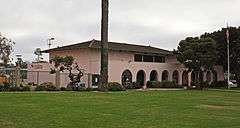
In 1896 journalist and publisher Ellen Browning Scripps settled in La Jolla, where she lived for the last 35 years of her life. She was wealthy in her own right from her investments and writing, and she inherited a large sum from her brother George H. Scripps in 1900. Unmarried and childless, she devoted herself to philanthropic endeavors, particularly those benefiting her adopted home of La Jolla. She commissioned many of La Jolla's most notable buildings, usually designed by Irving Gill or his nephew and partner Louis John Gill. Many of these buildings are now on the National Register of Historic Places or are listed as historic by the city of San Diego; these include the La Jolla Woman's Club (1914), the La Jolla Recreational Center (1915), the earliest buildings of The Bishop's School, and the Old Scripps Building at the Scripps Institution of Oceanography, as well as her own residence, built in 1915 and now housing the Museum of Contemporary Art San Diego. Her donations also launched the Scripps Memorial Hospital in 1924 (originally located on Prospect Street in La Jolla until it moved to its present site in 1964), the Scripps Metabolic Clinic (now the Scripps Research Institute), and the Children's Pool. Ellen Browning Scripps also founded Scripps College, a women's college, in 1926.[19] Scripps College is located in Claremont in Los Angeles County (not to be confused with Clairemont, a community of San Diego).
Scripps Institution of Oceanography
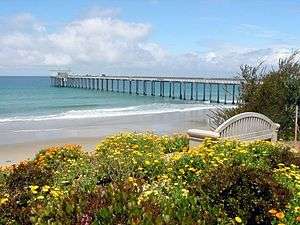
The Scripps Institution of Oceanography, one of the nation's oldest oceanographic institutes, was founded in 1903 by William Emerson Ritter, chair of the zoology department at the University of California, with financial support from Scripps and her brother E. W. Scripps. At first the institution operated out of a boathouse in Coronado. In 1905 they purchased a 170-acre (0.69 km2) site in La Jolla where the Institution still stands today. The first laboratory buildings there opened in 1907. The institution became part of the University of California in 1912. Ultimately it became the nucleus for the establishment of the University of California, San Diego.
Camp Matthews
From 1917 through 1964 the U.S. Marine Corps maintained a military base in La Jolla. The base was used for marksmanship training and was known as Camp Calvin B. Matthews. During and after World War II the population of La Jolla grew, causing residential development to draw close to the base, so that it became less and less suitable as a firing range because of risk to the adjacent civilian population.[20] Meanwhile, the site was being eyed as a location for a proposed new campus of the University of California. In 1962 Camp Matthews was declared surplus by the Marine Corps. The base formally closed in 1964, and that same year the first class of undergraduates enrolled in the University of California, San Diego.
University of California
Local civic leaders had long toyed with the idea of a San Diego campus of the University of California, and the quest became more definite following World War II. The Scripps Institution of Oceanography, under its director Roger Revelle, had become an important defense contractor, and local aerospace companies like Convair were pressing for local training for their scientists and engineers. The state legislature proposed the idea in 1955, and the Regents of the University formally approved it in 1960.[21] The campus was originally named "University of California, La Jolla", but the name was changed to "University of California, San Diego" in 1960.[22] The founding chancellor was Herbert York, named in 1961, and the second chancellor was John Semple Galbraith, named in 1964. The university was designed to have a "college" system; there are now six colleges. The first college was established in 1965 and was named Revelle College after Roger Revelle, who is regarded as the "father" of the university.[22] A medical school was established in 1968. The landmark Geisel Library with its Brutalist architecture opened in 1970.
Antisemitism
The Camp Matthews site for the University was selected with some hesitation; one of the concerns was "whether La Jollans in particular would lay aside old prejudices in order to welcome a culturally, ethnically, and religiously diverse professoriate into their midst".[21] La Jolla had a history of restrictive housing policies, often specified in deeds and ownership documents. In La Jolla Shores and La Jolla Hermosa, only people with pure European ancestry could own property; this excluded Jews, who were not considered white. Such "restrictive covenants" were once fairly common throughout the United States; the 1948 Supreme Court case Shelley v. Kraemer ruled them to be unenforceable, and Congress outlawed them twenty years later via the Fair Housing Act (Title VII of the Civil Rights Act of 1968).[23] However, realtors and property owners in La Jolla continued to use more subtle ways of preventing or discouraging Jews from owning property there.[24] Revelle stated the issue bluntly: "You can't have a university without having Jewish professors. The Real Estate Broker's Association and their supporters in La Jolla had to make up their minds whether they wanted a university or an anti-Semitic covenant. You couldn't have both."[25] The issue was overcome; La Jolla now boasts a thriving Jewish population,[26] and there are four synagogues in La Jolla.[27]
Mount Soledad cross
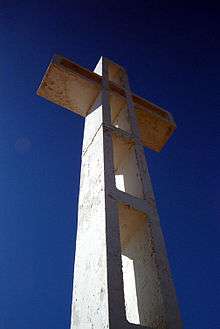
Mount Soledad is a 822-foot (251 m) tall hill on the eastern edge of La Jolla, one of the highest points in San Diego. A large Christian cross was placed at the top in 1913 as a prominent landmark. It has been replaced twice, most recently in 1954 with a 29-foot-tall (8.8 m) cross (43 feet tall, including the base). Originally known as the "Mount Soledad Easter Cross", its presence on publicly owned land was challenged in the 1980s as a violation of the separation of church and state. Since then the cross has had a war memorial built around it and was renamed "Mount Soledad Veterans War Memorial".[28] The issue has been in almost continual litigation ever since, with the city attempting to sell or give away the land under the cross. By an act of Congress, the federal government took possession of it under eminent domain in 2006. The United States Court of Appeals for the Ninth Circuit declared the cross unconstitutional in 2011, and the Supreme Court of the United States declined to hear an appeal.[29] In December 2013, U.S. District Judge Larry Burns ordered that the cross be removed within 90 days, but stayed the order pending a forthcoming appeal by the government.[30][31]
On July 20, 2015, a group called the Mt. Soledad Memorial Association reported that it had bought the land under the cross from the Dept. of Defense for $1.4 million.[32] On September 7, 2016 the 9th U.S. Circuit Court of Appeals issued a one-page ruling, ordering dismissal of the case and an end to all current appeals, stating that the case was now moot because the cross was no longer on government land. Both sides agreed that this decision puts a final end to the case.[33]
Arts
La Jolla became an art colony in 1894 when Anna Held (also known as Anna Held Heinrich) established the Green Dragon Colony. This was a cluster of twelve cottages designed by Irving Gill, who had moved to San Diego only a year earlier and later became San Diego's best-known architect.[34]
The La Jolla Playhouse was founded in 1947 by Gregory Peck, Dorothy McGuire, and Mel Ferrer.[35] It became inactive in 1959, but was revived in 1983 on the University of California campus under the leadership of Des McAnuff. It now incorporates three theaters: the Mandell Weiss Theatre (1983), the Mandell Weiss Forum (1991) and the Potiker Theater (2005).
The Museum of Contemporary Art San Diego was founded in 1941 in La Jolla, in the former home of Ellen Browning Scripps (designed by Irving J. Gill). The museum has undergone several renovations and expansions, and is working on plans to triple its size.[36][37]
Geography


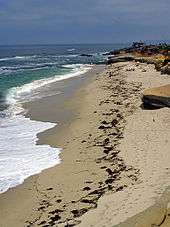
Demarcation
The community's border starts at Pacific Beach to the south and extends along the Pacific Ocean shoreline north to include Torrey Pines State Reserve ending at Del Mar, California. La Jolla encompasses the neighborhoods[38] of Bird Rock, Windansea Beach, the commercial center known as the Village of La Jolla, La Jolla Shores, La Jolla Farms, Muirlands, Torrey Pines, and Mount Soledad to name a few.
The City of San Diego defines the community's eastern boundary as Gilman Drive and the Interstate 5 freeway[39] and the northern boundary as the University of California, San Diego (UCSD).[40]
The U.S. Postal Service defines a somewhat larger area, assigning the community the 92037 ZIP code, recognizing it as a historically and geographically distinct area. This unique ZIP code allows addresses to read La Jolla, CA, and is the only community within the City of San Diego so recognized. Additionally, it is in the 919xx/920xx sequence used for suburban and rural ZIP codes in San Diego County, rather than the 921xx sequence used for the remainder of the City of San Diego itself. These conditions sometimes lead to the erroneous impression that La Jolla is a separate city rather than a part of San Diego. The 92037 ZIP code extends the northeasterly boundary to Genesee Avenue and the northerly boundary to Del Mar, California. The UCSD campus, although it is part of La Jolla, has ZIP codes 92092 and 92093.
Geology
La Jolla is an area of mixed geology, including sandy beaches and rocky shorelines. The area is occasionally susceptible to flooding and ocean storms, as occurred in January and December 2010.[41]
Mount Soledad is covered with the narrow roads that follow its contours and hundreds of homes overlooking the ocean on its slopes. It is the home of the large concrete Mount Soledad Easter Cross built in 1954, later designated a Korean War Memorial, that became the center of a controversy over the display of religious symbols on government property.
The most compelling geographical highlight of La Jolla is its ocean front, with alternating rugged and sandy coastline, and wild seal congregations. Popular beaches and coastal access points listed here from north to south, are:
- Torrey Pines State Reserve
- Black's Beach (a de facto nude beach)
- Scripps, near Scripps Institution of Oceanography
- La Jolla Shores
- La Jolla Beach and Tennis Club
- La Jolla Cove
- Boomers Beach
- Shell Beach
- Children's Pool Beach
- Wipeout Beach
- Horseshoes
- Marine Street
- Windansea Beach
- Bird Rock
Demographics
According to U.S. Census Bureau figures, the ethnic/racial makeup of La Jolla is 82.5% White, 0.8% Black, 0.2% American Indian, 11.2% Asian, 0.1% Pacific Islander, 2.0% some other race, and 3.1% two or more races. Latinos, who may be of any race, form 7.2% of La Jolla's population.
La Jolla had the highest home prices in the nation in 2008[42] and 2009,[43] according to a survey by Coldwell Banker. The survey compares the cost of a standardized four-bedroom home in communities across the country. The average price for such a home in La Jolla was reported as US$1.842 million in 2008 and US$2.125 million in 2009.

Neighborhoods
- La Jolla Farms – This northern La Jolla neighborhood is just west of UCSD. It includes the Torrey Pines Gliderport, the Salk Institute, and a group of expensive homes on the cliffs above Black's Beach.
- La Jolla Shores – The residential area and the Scripps Institution of Oceanography campus along La Jolla Shores Beach and east up the hillside. Also includes a small business district of shops and restaurants along Avenida de la Playa.
- La Jolla Heights – The homes on the hills overlooking La Jolla Shores. No businesses.
- Hidden Valley – Lower portion of Mount Soledad on the northern slopes. No businesses.
- Country Club – Lower Mt. Soledad on the northwest side, including the La Jolla Country Club golf course.
- Village – Also called Village of La Jolla (not to be confused with La Jolla Village) the "downtown" business district area, including most of La Jolla's shops and restaurants, and the immediately surrounding higher density and single family residential areas.
- Beach-Barber Tract – The coastal section from Windansea Beach to the Village. A few shops and restaurants along La Jolla Boulevard.
- Lower Hermosa – Coastal strip south of Beach-Barber Tract. No businesses.
- Bird Rock – Southern coastal La Jolla, and the very lowest slopes of Mt. Soledad in the area. Notable for shops and restaurants along La Jolla Boulevard, five traffic roundabouts on La Jolla Boulevard, coastal bluffs, and surfing areas just two blocks off the main drag.
- Muirlands – Relatively large area on western middle slope of Mt. Soledad. No businesses.
- La Jolla Mesa – A strip on the lower southern side of Mt. Soledad, bordering Pacific Beach. No businesses.
- La Jolla Alta – A master-planned development east of La Jolla Mesa. No businesses.
- Soledad South – Southeastern slopes of Mt. Soledad, all the way up to the top, east of La Jolla Alta.
- Muirlands West – The small neighborhood between Muirlands to the south, and Country Club to the north. No businesses.
- Upper Hermosa – Southwestern La Jolla, north of Bird Rock and east of La Jolla Blvd.
- La Jolla Village - Not to be confused with the Village (of La Jolla). In northeast La Jolla, east of La Jolla Heights, west of I-5 and south of UCSD. The neighborhood's namesake is the La Jolla Village Square shopping and residential mall, which includes two movie theaters.
Community groups
The La Jolla Community Planning Association[44] advises the city council, Planning Commission, City Planning Department as well as other governmental agency as appropriate in the initial preparation, adoption of, implementation of, or amendment to the General or Community Plan as it pertains to the La Jolla area as well as review specific development proposals.[45] The nonprofit La Jolla Town Council[46] represents the interests of La Jolla businesses and residents that belong to the Council. The Bird Rock Community Council[47] serves the Bird Rock neighborhood, while the La Jolla Shores Association[48] serves the La Jolla Shores neighborhood. La Jolla Village Merchants Association, Inc. is a non-profit organization formed in February 2011 to manage the La Jolla Village Business Improvement District for the City of San Diego.[49]
Community organizations include Independent La Jolla,[50] a membership-based citizens group seeking to secede from the city of San Diego. Service clubs in La Jolla include Kiwanis, Rotary, La Jolla Woman's Club[51] and the Social Service League of La Jolla,[52] to name a few.
Attractions and activities

La Jolla is the location of Torrey Pines Golf Course, site each January or February of a PGA Tour event formerly known as the Buick Invitational and – since 2010 – called the Farmers Insurance Open.[53] In 2008, Torrey Pines also hosted the 2008 U.S. Open. Nearby are the de facto nude beach, Black's Beach, and the Torrey Pines Gliderport.[54]
Downtown La Jolla is noted for jewelry stores, boutiques, upmarket restaurants and hotels. Prospect Street and Girard Avenue are also shopping and dining districts.[55] The Museum of Contemporary Art, founded in 1941, is located just above the waterfront in what was originally the 1915 residence of philanthropist Ellen Browning Scripps. The museum has a permanent collection with more than 3,500 post-1950 American and European works, including paintings, works on paper, sculptures, photographic art, design objects and video works.[56] The museum was renamed Museum of Contemporary Art San Diego in 1990 to recognize its regional significance.
Beaches and ocean access include Windansea Beach, La Jolla Shores, La Jolla Cove and Children's Pool Beach. For many years, La Jolla has been the host of a rough water swim at La Jolla Cove.[57]
In 2011, the La Jolla Community Foundation commissioned various artists to contribute to the scenery of the town, through various murals. Some of the artists that are featured in the series are John Baldessari, Julian Opie, and Kim MacConnell. There are 11 murals in the series, all of which will be on display for two years.[58]
Landmarks
- Bed & Breakfast Inn at La Jolla
- The Bishop's School
- Grande Colonial Hotel
- La Jolla Woman's Club
- La Jolla Recreational Center
- KGTV Tower
- Mt. Soledad Memorial
- Museum of Contemporary Art San Diego (Ellen Browning Scripps residence)
- The 12 Green Dragon Buildings
- La Valencia (Cabrillo) Hotel
- Wisteria Cottage, home of the La Jolla Historical Society
Education
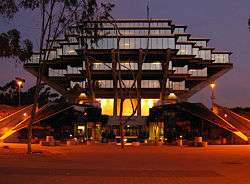
Higher education
The University of California, San Diego is the center of higher education in La Jolla. The campus' original name was UC La Jolla before it was changed to UC San Diego. UCSD includes the Scripps Institution of Oceanography and the San Diego Supercomputer Center.
National University is also headquartered in La Jolla, with several academic campuses located throughout the county and the state. Among the several research institutes near UCSD and in the nearby Torrey Pines Science Park are The Scripps Research Institute, the Sanford-Burnham Medical Research Institute (formerly called the La Jolla Cancer Research Foundation), La Jolla Institute for Allergy and Immunology (LIAI) and the Salk Institute.
Other schools
La Jolla is served by the San Diego Unified School District. Public schools include La Jolla High School, La Jolla Elementary[59] (which was the first public school, built in 1896 with the first classes in the Heald Store at the corner of Herschel Avenue and Wall Street, later moving to its present location on Girard Avenue), Muirlands Middle School,[60] Torrey Pines Elementary,[61] and Bird Rock Elementary,[62] as well as The Preuss School UCSD, a public charter school. The community's prep schools are The Bishop's School, which was the first private school opened in 1909, The Children's School,[63] Delphi Academy, Stella Maris Academy,[64] The Gillispie School, and the Evans School. La Jolla Country Day School is located in the nearby community of University City.
Religious institutions
Christian:
- All Hallows Catholic Church[56]
- Assembly of God[56]
- Christian Science Church[56]
- Congregational Church (the first church built; burned down in 1915 and re-built in 1916 on 1216 Cave Street)[56]
- Barabbas Road Church[65]
- First Baptist Church
- La Jolla Christian Fellowship
- La Jolla Lutheran Church[56]
- La Jolla Presbyterian Church[56]
- La Jolla Religious Society of Friends[56]
- La Jolla United Methodist Church[56]
- Mary, Star of the Sea Catholic church[56]
- Prince Chapel by the Sea (AME church) [56]
- St. James by-the-Sea Episcopal[56]
- St. John Church of God in Christ[56]
- Torrey Pines Christian Church[56]
- University Lutheran Church[56]
Jewish:
Business and media
La Jolla was home to the comic book publisher Wildstorm Productions, from its founding by Jim Lee in 1993, until its closing in 2012 when DC Comics, which had purchased the publisher as an imprint in 1998, absorbed the company and moved the office to Burbank, CA.[66][67][68][69]
La Jolla is the setting for the 2011 season of The Real World: San Diego, the twenty-sixth season of the long-running MTV reality television series.[70][71]
La Jolla is the base for the Sundt Memorial Foundation, a national organization aimed at discouraging youth from getting involved in drugs.
Notable people
La Jolla has been the home to many notable people, including prominent scientists, business people, artists, writers and performers.
See also
References
- 1 2 "Population and Housing Estimates, Zip Code 92037" (PDF). 2004 Estimates. Archived from the original (PDF) on 2006-07-18. Retrieved 2006-10-15.
- ↑ Langman, Lauren (2006). The Evolution of Alienation: Trauma, Promise and the Millennium. Rowman & Littlefield. p. 10. ISBN 0742518353.
... on the sea, La Jolla, a very affluent community; ...
- ↑ Glionna, John (May 10, 1992). "Down and Out in La Jolla : Sociology: Affluent community can be a paradise for the homeless, too, but the gap between the haves and the have-nots is magnified.". Retrieved October 31, 2016.
- ↑ "Full List: America's Most Expensive ZIP Codes 2015". Forbes. 2015. p. 6. Retrieved October 31, 2016.
- ↑ Hogan, Richard (2003). The Failure of Planning: Permitting Sprawl in San Diego Suburbs, 1970-1999. Ohio State University Press. p. 90. ISBN 0814209238.
...the battle for the beach reached its climax in the wealthy northern community of La Jolla
- ↑ Bauder, Don (September 22, 2010). "La Jolla 5th Most Expensive Home Market in Nation". San Diego Reader. Retrieved 31 October 2016.
- 1 2 "SanDiego.org". SanDiego.org. Retrieved 2010-06-30.
- ↑ US. "Mapquest". Mapquest. Retrieved 2010-06-30.
- ↑ "San Diego City". Sandiego.gov. Retrieved 2010-06-30.
- ↑ "SanDiego.org". SanDiego.org. Retrieved 2010-06-30.
- ↑ "Weather.com". Weather.com. 2009-06-17. Retrieved 2010-06-30.
- ↑ "DiscoverSD". DiscoverSD. Retrieved 2010-06-30.
- ↑ "La Jolla, CA Official Website". Lajollabythesea.com. Retrieved 2010-06-30.
- ↑ Langdon 1970
- ↑ "History of La Jolla". La Jolla Playhouse, via Wayback Machine. Archived from the original on November 3, 2011. Retrieved September 30, 2014.
- ↑ Ray, Nancy (August 31, 1985). "One of La Jolla's Best-Kept Secrets Is Fun Ride". Archived from the original on June 22, 2014. Retrieved June 22, 2014.
- 1 2 3 Hollins, Jeremy. "Village Memories: A Photo Essay on La Jolla's Past" (PDF). Journal of San Diego History: 295–305.
- ↑ Rannells, Nathan L. (October 1958). "La Jolla No. 1". Journal of San Diego History. 4 (4).
- ↑ http://www.scrippscollege.edu/about/ellen-browning-scripps
- ↑ Denger, Mark J. "A Brief History of the U.S. Marine Corps in San Diego". The California State Military Museum. Retrieved 21 May 2013.
- 1 2 Shragge, Abraham J. (Fall 2001). "Growing Up Together: The University of California's One Hundred-Year Partnership with the San Diego Region". Journal of San Diego History. 47 (4).
- 1 2 "Timeline". University of California, San Diego. Retrieved 23 May 2013.
- ↑ "Title VIII: Fair Housing and Equal Opportunity". U.S. Department of Housing and Urban Development. Retrieved 11 February 2015.
- ↑ For example, when the world-famous mathematician and philosopher Jacob Bronowski came to the Salk Institute in 1963, he wanted to build a home on La Jolla Farms Road for his family. For his required character references, his family produced letters from members of Parliament, in Garson, Sue (2003). "The End of Covenant". The San Diego Jewish Journal. Archived from the original on July 23, 2008. Retrieved 2010-06-30.
- ↑ Carless, Will (2005-04-07). "A specter from our past: Longtime residents will always remember the stain left on the Jewel by an era of housing discrimination". LaJollaLight.com. Archived from the original on 2010-07-01. Retrieved 2010-06-30.
- ↑ Stratthaus, Mary Ellen (1996). "Flaw in the Jewel: Housing Discrimination Against Jews in La Jolla, California". American Jewish Historical Society. Archived from the original (PDF) on 2010-07-01. Retrieved 2010-06-30.
- ↑ Google.com. "Synagogues in La Jolla". Google Maps. Retrieved May 9, 2013.
- ↑ "Appeals court says cross on federal land is unconstitutional". CNN. January 5, 2011. Retrieved 23 May 2013.
- ↑ "Supreme Court won't hear Mt. Soledad cross case". San Diego Union Tribune. June 25, 2012. Retrieved 23 May 2013.
- ↑ Wolski, Kristi (December 12, 2013). "Federal judge says Mt. Soledad cross must come down". Fox 5 San Diego. Retrieved 14 December 2013.
- ↑ Davis, Kristina (December 12, 2013). "Judge: Mt. Soledad cross must come down". San Diego Union Tribune. Retrieved 14 December 2013.
- ↑ http://www.washingtontimes.com/news/2015/jul/20/mt-soledad-cross-stand-veterans-group-buys-land-de/
- ↑ Moran, Greg (September 8, 2016). "Soledad cross case concludes, leaving memorial in place". San Diego Union-Tribune. Retrieved 9 September 2016.
- ↑ Stern, Jean. "Artists in La Jolla, 1890–1950" (PDF). Journal of San Diego History: 281–287.
- ↑ "Playhouse Highlights". La Jolla Playhouse. Retrieved May 23, 2013.
- ↑ Ng, David (March 17, 2014). "Museum of Contemporary Art San Diego picks architect for expansion". Los Angeles Times. Archived from the original on June 22, 2014. Retrieved June 22, 2014.
- ↑ Sherman, Pat (July 28, 2015). "La Jolla's permit reviewers approve museum expansion". La Jolla Light. Retrieved 28 May 2016.
- ↑ "map of La Jolla neighborhoods". Ruthmillsteam.com. Retrieved 2010-06-30.
- ↑ "San Diego City Department". Sandiego.gov. Retrieved 2010-06-30.
- ↑ "Northern Neighborhood | Neighborhood Maps". Sandiego.gov. Retrieved 2010-06-30.
- ↑ Schwab, Dave (January 20, 2010). "Flooding closes gym on La Jolla's Pearl Street". La Jolla Light. Archived from the original on June 22, 2014. Retrieved June 22, 2014.
- ↑ Business Week, September 9, 2008
- ↑ San Diego Union Tribune, September 24, 2009
- ↑ "La Jolla Community Planning Association". Lajollacpa.org. Retrieved 2010-06-30.
- ↑ "La Jolla Community Profile". Sandiego.gov. Retrieved 2010-06-30.
- ↑ "La Jolla Town Council". La Jolla Town Council. Retrieved 2010-06-30.
- ↑ "Bird Rock Community Council". Birdrock.org. Retrieved 2010-06-30.
- ↑ "La Jolla Shores Association". Lajollaguide.com. Retrieved 2010-06-30.
- ↑ La Jolla Village Merchants Association website
- ↑ "Independent La Jolla". Independent La Jolla. Retrieved 2010-06-30.
- ↑ Triqqer Code House. "La Jolla Women's Club". Lajollawomansclub.com. Retrieved 2010-06-30.
- ↑ "Social Service League of La Jolla". Darlingtonhouse.com. Retrieved 2010-06-30.
- ↑ "Farmers Insurance Open website". Farmersinsuranceopen.com. Retrieved 2010-06-30.
- ↑ Sherman, Pat (April 22, 2014). "La Jolla native chronicles Gliderport's rich history in new book". La Jolla Light. Archived from the original on June 22, 2014. Retrieved June 22, 2014.
- ↑ "La Jolla". Where. Archived from the original on June 22, 2014. Retrieved June 22, 2014.
- 1 2 3 4 5 6 7 8 9 10 11 12 13 14 15 16 17 Schaelchlin, Patricia. La Jolla: The Story of a Community 1897-1987, Friends of the La Jolla Library, San Diego, 1988
- ↑ La Jolla Rough Water Swim
- ↑ http://www.lajollabluebook.com/blog/murals-of-la-jolla/
- ↑ La Jolla Elementary School
- ↑ "Muirlands | San Diego Unified School District". www.sandiegounified.org. Retrieved 2016-03-12.
- ↑ Torrey Pines Elementary
- ↑ Bird Rock Elementary School
- ↑ The Children's School
- ↑ Stella Maris Academy, All Hallows Academy
- ↑ http://www.whoisbarabbas.com/
- ↑ Wells, Aaron. "Wild, wild comic art", La Jolla Light, July 25, 2008
- ↑ Iyoho, Charles. "Are Superheroes Fleeing La Jolla?", La Jolla Patch, October 18, 2010
- ↑ Phegley, Kiel. "WildStorm & Zuda Imprints Close Amidst DC Changes", Comic Book Resources, September 21, 2010
- ↑ "A day of change: bye bye, WildStorm; so long, Zuda", The Beat, September 21, 2010
- ↑ Dehnart, Andy (June 7, 2011). "Real World returning to San Diego for its 26th season". RealityBlured.com. Retrieved June 7, 2011.
- ↑ "MTV’s Real World will screen from La Jolla, California according to San Diego Movers", Titan Movers, May 27, 2011
Further reading
- Langdon, Margaret (1970). A grammar of Diegueno: the Mesa Grande dialect. Berkeley: University of California Press.
- Schaelchlin, Patricia (1988). La Jolla: The Story of a Community 1897-1987. La Jolla: Friends of the La Jolla Library.
External links
| Wikimedia Commons has media related to La Jolla, San Diego. |
| Wikivoyage has a travel guide for La Jolla. |
Coordinates: 32°50′24″N 117°16′37″W / 32.84000°N 117.27694°W
